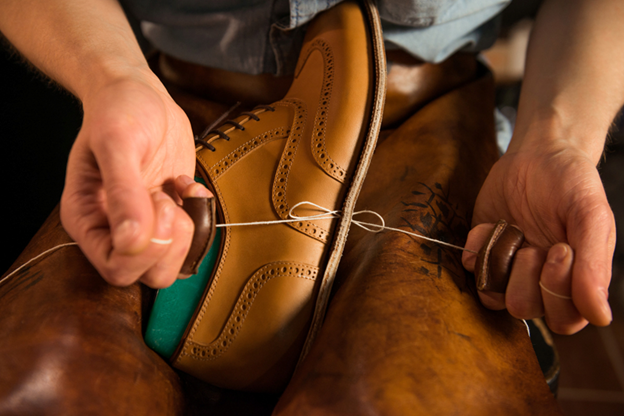Introduction
When it comes to durable footwear, we usually pay attention to the material composition of the outer sole, the cushioning technology, or even the kind of leather or mesh we have as an upper. It is, however, one of the most underrated, most critical components of long-lasting shoes, though just like the nails that keep a house together, the thread keeps every piece of footwear together and binds every piece of footwear in a way that will ensure functionality, comfort, and durability. It’s the thread that is the source of the power that will see how long your shoes will last under pressure, whether it’s a pair of rugged hiking boots or stylish designer loafers.
In this article, we’ll explore these reasons for thread being so important for footwear construction, how different kinds of thread contribute to the longevity, thread technology science, and what innovations are taking the footwear stitching into the future.
The Invisible Backbone: Why Thread Matters
Thread is the connective carbohydrate of footwear construction. It covers the sole to the upper and fastens overlays and stresses because these parts move continuously and bear constant churn. In fact, the strength and sagacity of the thread sometimes are deciding elements whether the shoe is to fall apart after a couple of months or will sustain the years of hard use.
As opposed to adhesives or molded components, stitching is plastic. This permits the shoe to perform as a supple unit with the foot, however, maintaining the structural integrity. Good-looking and comfortable shoes may be, but when the thread fails, they become useless. For this reason, footwear manufacturers spend a great deal of money seeking the appropriate kind of thread for the shoe based on the use, material compatibility, and the expected life span of the shoe.
Historical Perspective: Evolution of Thread in Footwear
Previously, threads for shoemaking were typically made from natural materials such as cotton, linen, or silk. Every piece of footwear was hand-stitched by cobblers using waxed linen threads to secure components. These were well suited for what they were needed for, but were quite vulnerable to moisture, abrasion, and UV exposure.
Nylon and polyester then replaced natural threads in shoemaking once they were introduced in the beginning of the Industrial Revolution. These materials had much improved tensile strength, chemical resistance, and manufacturing consistency. Today we have advanced threads that are meant to work in the most extreme environments: heat, friction, chemicals and intense physical stress without breaking.
Types of Thread Used in Footwear
Modern shoemaking employs a variety of threads, each selected for specific needs. Let’s explore the most common types:
- Nylon Thread
The most commonly used thread in the footwear production is nylon. It is extremely flexible, very resistant to abrasion, and strong. It is actually great for sports shoes, children’s footwear, and military boots, which undergo a lot of wear and tear.
- Polyester Thread
It also resists UV radiation and chemicals, and it’s well known for the fact that it is the polyester thread. It is slightly less elastic than nylon but has excellent colorfastness and is used in outdoor or work footwear exposed to harsh elements. Polyester embroidery thread is used to make intricate embroidery on various footwear.
- Kevlar Thread
Kevlar threads are very strong and heat resistant. Kevlar is primarily used in tactical or industrial footwear, so it can withstand high stress and flames, or cuts. But it’s overkill for casual shoes and extremely expensive.
- Cotton Thread
Cotton is not as strong and durable as synthetic threads, but it’s still used for decorative stitching, or when the aesthetic has to be of high fashion and breathability is an important factor, as is the case in leather shoes.
- Monofilament Thread
Monofilament thread consists of a single strand of nylon or polyester and is clear, and is used where visibility of the thread should be minimized. But they don’t bend as easily, nor are they as soft as some.
- Bonded Thread
Resin or bonding agent is used in bonding threads to minimize fraying and enhance speed performance during high-speed stitching. These are good production lines where consistency and strength are critical. Examples include bonded nylon thread.
Stitching Techniques That Boost Durability
The type of thread is only part of the equation. The stitching technique significantly influences the strength of the shoe. Key methods include:
- Lock Stitch
This method is generally used in most other types of footwear and consists of making a knot between the bobbin thread and the upper. This one is versatile and strong, and good for leather or textile uppers.
- Chain Stitch
In the decorative or flexible seams, this method is utilized. It allows for better stretch but will unravel more easily if broken.
- Zigzag Stitch
It is used in areas that need elasticity, that is, in the sports footwear. It also allows for foot movement within its zigzag pattern while posing no danger to the seam.
- Goodyear Welt Stitching
This technique is found in high-end leather shoes: Stitching the upper and the insole together, then the sole is attached. The process is labor-intensive and allows them to resolve and extend the life of a shoe by decades.
- Blake Stitching
Blake stitching is more flexible as it sews only one stitch that runs through the sole and the insole. It’s not waterproof, but it is svelte and less durable than many other cases.
Environmental Stressors: What Threads Must Withstand
Surprisingly, footwear endures a lot of abuse. Each step averages 5000 steps for the average person each day, and each step reacts with friction, flex, and weight-bearing stress. Threads must endure:
- Abrasion from internal foot movement
- Moisture from sweat and environmental exposure
- Chemical exposure from roads, salt, or cleaning agents
- UV damage from sunlight
- It can be repeated flexing that can fray or weaken the fibers.
Polyester or bonded nylon synthetic threads are preferred in synthetic footwear that is resistant to all these stressors without loss of tensile strength or elasticity.
Innovations in Thread Technology
The thread is now an innovative place rather than simply about sewing. Some of the most recent developments are:
- Smart Threads: Equipped with sensors for medical monitoring or fitness tracking.
- Self-Healing Threads: Polymers that can repair small cuts or tears.
- Waterproof Thread Coatings: Sophisticated treatments that improve thread performance in humid conditions.
- Color-Changing Threads: Threads that change color in response to moisture or temperature, either for fashion or as a wearing sign.
These technologies are still in their infancy, but they demonstrate how even the most basic parts of footwear can be improved with technology.
How to Spot a Good Thread in Shoes
Although consumers seldom consider checking thread quality, there are indicators you may look for:
- Consistent Stitching: Uniform spacing and closely spaced stitches suggest high-quality control and machine accuracy.
- Double Stitching or Reinforcement: Present in stress-prone areas such as heel counters or toe boxes.
- Bonded or Waxed Threads: These resist fraying and have a smoother texture.
- Heavy-Duty Threads: Thicker, stronger threads that are common in outdoor or work footwear indicate longevity.
When buying high-end or specialty shoes, inquire about the thread type. Brands that highlight their stitching methods shouldn’t be avoided; they are generally more dedicated to durable construction.
The Thread in Repair and Resole Culture
Shoe repair has become more popular as people are trying to reduce waste, keep high-quality goods. In this case, the role of the thread is even more important. Worn-out stitching is replaced by higher-grade thread to make the cobbler’s life last longer. Welted (Goodyear, or Norwegian, for example) construction is especially repair-friendly as the sole can be replaced with the original upper, and the structure remains intact.
Conclusion
Thread may be a small component in a shoe, but it is a big player when it comes to durability, comfort, and how your shoes will perform. Whether in high-performance athletic sneakers, handcrafted leather boots, or lightweight summer sandals, the right thread is used so that every element of a shoe holds together each day under wear and tear.
Since consumers increasingly demand durable, sustainable, and high-performance footwear, brands and manufacturers have to keep finding ways to innovate in such an underrated area. A shoe is as good as the shoelace holding it together, and when the thread is weak, the shoelace will break.




